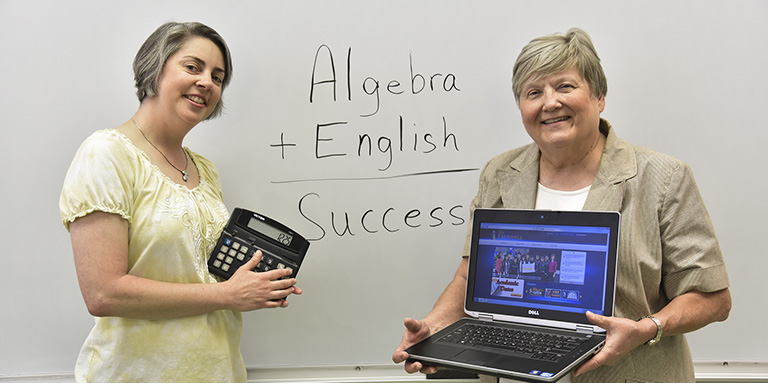San Jacinto College: New Unique Course Combines Algebra and Composition

San Jacinto College launched a collaborative course in the fall 2015 semester that incorporates algebra and English composition. The new course links college algebra and introductory composition, both gateway core courses for all students who plan to either earn associate degrees or transfer to universities.
“This is a novel concept at San Jacinto College,” commented Mark Johnson, North Campus language arts department chair.
The course explores the power of narrative in math and English. Give a person some facts and part of the brain lights up. Tell a person a story and the whole brain lights up. The goal is to help students think differently about algebra and composition, two courses that can hold back students from completing degrees.
Johnson says research indicates there are strong correlations between success in language arts and success in math. He cites, for example, an essay by Dr. Gene Fite, Kansas City Public Schools curriculum coordinator, that states:
The cognitive ability that drives symbol processing is the connection between language and math. The symbol processing ability is the basis for both language proficiency and math achievement… Reading and math share common elements. They both involve abstract, symbolic cognitive processes, and they both require a working knowledge of the interaction of numerous discrete skills.
Research also indicates that a key reason many students struggle in algebra is that they struggle reading and understanding the language that surrounds math. “In essence, they have difficulty understanding what is being asked of them,” commented Johnson. “They can ‘do’ the algebra, often, but fail at interpreting the verbal language around the math.” San Jacinto College’s new linked math-English course helps students to better interpret the narrative component that is integral to algebra.
In the linked math-English course, students work in a cohort model, staying together for both subjects, which are taught in tandem by an English professor and a math professor. Students who complete the linked course satisfy the math portion, as well as one of the two communication components of basic college core requirements.
The course is taught in a learning community environment that includes mentoring and tutoring. “Students have peer support in and out of the classroom,” remarked Johnson. “They also receive specialized instructor support in and out of the classroom.”
English professor Dr. Karen Hattaway, who teaches the composition component, says the algebra and English are actually two separate courses that are taught in a learning community, not one course that combines algebra and English. “Students earn six hours of credit, working together in algebra on Mondays and Wednesdays, and then again in English on Tuesdays and Thursdays,” she said. “The emphasis is on creating a community of learners. Studies show that learning communities support uncertain students more than stand-alone courses because the students have a recognized circle of classmates who become colleagues in learning.”
Hattaway says the goal is to foster and improve critical thinking so that students can succeed in upper-division courses and in the business community. “Our industry partners say that some graduates cannot write clear reports, engage in business discourse, or apply their learning or industry experience to new situations,” she commented.
There is a recent trend to split STEM (science, technology, engineering, and math) from humanities with the result that STEM majors often struggle to express their ideas well enough to function in an information-heavy business environment. For students to succeed in a science and information age, they must be able to explain what they know and how this knowledge contributes to industry decisions. After all, even rocket science has to be explained to government budget developers.
The new algebra-English course is offered at the North Campus, exclusively in a traditional classroom environment, not in an online or hybrid format.
The course has been extremely popular with students, according to Mark Johnson. "It’s been a great success and we’re planning to offer more sections because of its success,” he said. “Plans are in the works to offer at least two sections for spring 2017."
Watch Dr. Hattaway talk about the new learning community here.
Photo caption: Math professor Kate Dinwiddie, left, teaches the algebra component, and English professor Dr. Karen Hattaway teaches the composition component of San Jacinto’s combined math and English course. Photo credit: Rob Vanya, San Jacinto College marketing, public relations, and government affairs department.
Rob Vanya is the Communications Coordinator at San Jacinto College in Pasadena, Texas.
Opinions expressed in Member Spotlight are those of the author(s) and/or submitting college and do not necessarily reflect those of the League for Innovation in the Community College.










